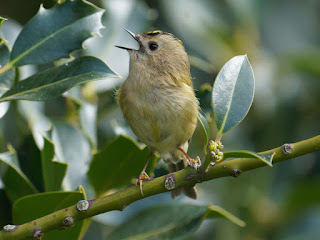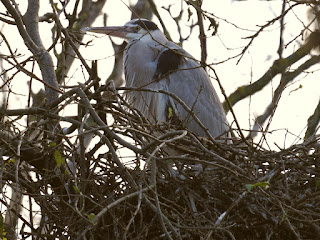There seemed to be a mass of larvae in this hole in a branch in the Dell, which was being explored by two Long-Tailed Tits.
A Blue Tit shooed them away so it could feed undisturbed.
A Dunnock looked for insects under a bench beside the Huntress fountain in the Rose Garden.
There was also a female Blackbird here ...
...and a Pied Wagtail at the Lido, on the same quest.
A sunny interval started a Goldcrest singing in a holly tree a short way north of the bridge.
There was no sign of the Mistle Thrush on Buck Hill, which was hardly surprising as a Sparrowhawk was passing overhead.
The fall of the leaves has exposed what I think is the Little Owls' hole in the horse chestnut tree next to the Serpentine Gallery. At any rate I can't see any other hole, and this one is large enough for the owl and would lead to a more spacious hollow in the tree. There was no sign of the owls. Although it wasn't cold, they would tend to stay inside till the park closed and they could come out to hunt on the ground.
Two Grey Herons were already in nests on the island,
The second one one was rebuilding the nest, which had fallen into disrepair after being used in the summer. Our herons start making nests early but then shilly-shally for months before actually breeding. In contrast, the herons in Battersea Park get the whole thing done around the New Year.
The younger of the two rabbits was at the Henry Moore sculpture ...
... but vanished in a flash when three herons landed.
The pigeon-eating Lesser Black-Backed Gull wasn't bothered by the notice, which said nothing about feeding on the wildlife.
A Great Crested Grebe cruised under the bridge.
A Mute Swan had a brisk wash and a mighty flap on the Serpentine.
Mallards ignored a heavy shower. I couldn't, and was sheltering under the bridge when I took this picture.
There are still some Common Wasps on the fatsia at the bridge.













Wasps are resilient indeed!
ReplyDeleteI guess the sound of the mighty wings flapping must be really noticeable, even from afar. I know that one of the rationalistic explanations of the notion of swansong put forth is the rhythmic beating of mute swans' wings in flight.
Pigeon Killer can read. I am entirely sure of that.
I have read that the sound of Mute Swans' wings -- which is unique to that species as other swans make little more noise in flight than geese -- acts as a flight call to keep a flock together.
DeleteSwans' wings sound like creaking hinges to me.
DeleteAnd Greylags, as they come in to splash down, make a noise like an old cane armchair recovering after someone has sat on it.
Delete